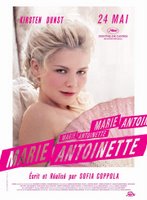 “She did not say that! There is no evidence that she did!”
“She did not say that! There is no evidence that she did!”This is my typical reaction when people bring up Marie Antoinette’s infamous line: “Let them eat cake.” Throughout history there have been many general misconceptions about the wife of King Louis XVI. Fortunately, Sofia Coppola decided to show people the Marie that historians know, basing her movie on the book Marie Antoinette by Antonia Fraser.
The movie begins with a very young Marie waking up and saying goodbye to her parents, Francis I and Maria Theresa of
Since receiving my bachelor’s degree in history in 2004, I have become very critical of so-called “historical” movies. And when I first heard that Kirsten Dunst would be playing the famous queen, I was extremely skeptical.. But Kirsten won me over. Although I know she is much older, she really did have me believing that she was a scared 14-year-old who was being married off to a stranger to ensure an alliance between two countries. She also seemed to grew as her character did, going from scared and confused to reckless and carefree to becoming a mother and accepting the responsibility that came with it, even if people in her court did not want her to.
Jason Schwartzman gave another fine performance as Louis XVI. He had already impressed me in Shopgirl, but he solidified my estimation of him with this performance. He showed the composure of a king but also some of the same lack of confidence that his wife shared, since they were both kinda thrown into the center ring at a young age—he was only 15 when he was married and only 20 when he ascended to the throne.
Most of the film was shot on location at
Although I did have some problems with some minor historical inaccuracies throughout the film, there was only one major flaw that I saw: The roles played by Molly Shannon and Shirley Henderson seemed completely inconsequential to me. I’m sure that they were part of the royal family—they seemed to be given some prominence, but the film never explains who they are. They seem just to be older gossips who talk about everyone, including Marie, acting completely nice to people’s faces while cutting them down behind their back.
Overall, the movie impressed me. I really enjoyed it and I always love seeing correct history being brought to the movie screen. It is definitely a movie I intend to buy when it is released, not out of any obligation to my chosen field of study, but because it showed what I love about history: It’s about the people who are involved and how they deal with and cause the situations that occur in their lives and around the world. I would give this movie a 12. Way to go Sofia! Although I liked Lost in Translation, this movie is MUCH more up my alley.
2 comments:
this is the 2nd time Sofia Coppola has worked with Kirsten Dunst, the 1st being The Virgin Suicides, and Coppola really seems to be hitting her stride here. i'd like it if you expounded more, Stormy Pinkness, on the music. what do you think about the inclusion of modern music, and the purpose of having it in there?
I think the use of the modern and classical music definitely helped to move things along. And it was not as out of place as it was in a Knight's Tale.
Post a Comment